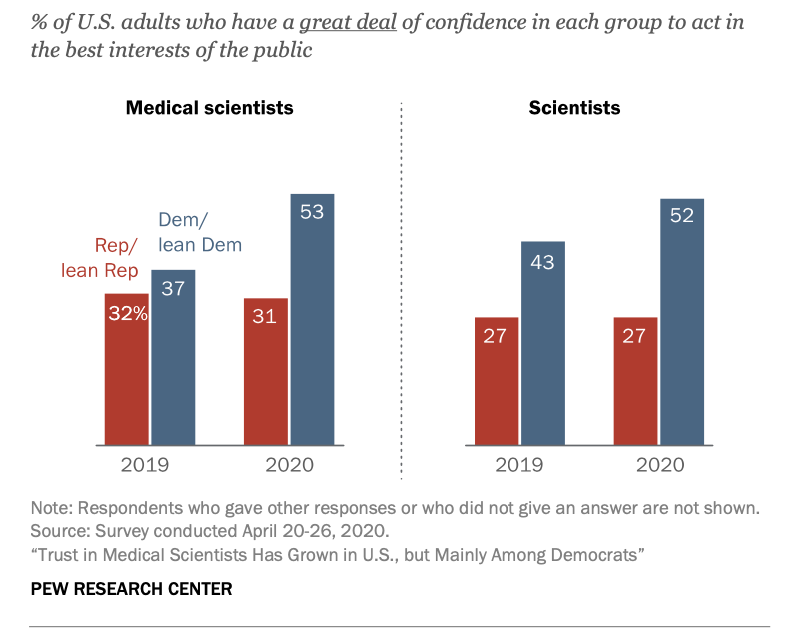During the COVID-19 pandemic, social media was an exceptionally powerful tool for scientists.
The scientific field of…science?
The world of science is growing and transforming every year. Ongoing trends like the coronavirus pandemic, the rise of preprints and open science, increasing incidents of scientific misconduct, and more have captured the research community’s attention.

Fortunately, ‘science’ is a major field for researchers. Every year, groundbreaking research studies come out on subjects like trust in scientists and their role in society and policymaking, research reproducibility, STEM education, research culture, data management and sharing, and more. So what are the biggest topics about ‘science’ that scientists are most actively researching and investigating?
In this field guide, NewsRx will present an overview on the biggest concerns faced by researchers—key research areas and ongoing discussions within the world of science. Read on for a contemporary look at the major debates, investigations, and subject areas that are all about examining and reexamining the essence of science.
Trust in scientists
Especially during the COVID-19 pandemic, the public’s trust in research and scientists emerged as a major concern. Research has shown that acceptance of protective COVID-19 measures by the public largely depended on the public’s trust in science.

According to the State of U.S. Science & Engineering 2022 report, while 84% of U.S. adults express “a fair amount” or a “great deal” of confidence in scientists, the trust varied significantly by education. Just 30% of U.S. adults with a high school degree or less expressed a great deal of confidence in scientists.
The pandemic’s impact on public trust in science is a mixed bag. Wellcome Global Monitor found that public trust in scientists rose during the pandemic, a 9% rise from the 2018 survey. At the same time, Harvard researchers have commented on how mixed messaging from politicians and a torrent of misinformation has worked to undermine trust in science during the pandemic.
Recent noteworthy studies include a University of Muenster article on predicting public trust in science, a London School of Economics study on how people who trust science were more likely to get vaccinated, and a University of Chicago Study on how the gap of trust in science between Democrats and Republicans is wider than ever.
Big data and machine learning
Science’s biggest concerns and priorities vary by field, but are nonetheless important to examine. Per a Sci-Ops 2021 survey, the top priorities for scientists, according to scientists, include enhancing public trust in science, advocating for climate policy, and confronting science denialism.
In the life sciences, per the Linus Group, the biggest techniques or applications scientists are focused on in 2022 are cell line engineering, multi-omics investigations, and machine learning. In terms of priorities for 2022, researchers said they were focused on adopting new techniques for work and automating more techniques and processes.
Multi-omics investigations and machine learning are noteworthy because they represent important trends for science even beyond the life sciences. Multi-omics is a biological analysis approach in which scientists combine multiple datasets from the “omes” (like the genome, epigenome, and microbiome) and analyze biological big data to find unique associations between biological entities. It’s an approach that derives from big data, and is related to machine learning techniques. Adopting machine learning and AI, automating research processes, and analyzing large datasets have become priorities for scientists across disciplines.

But the acceptance of big data and machine learning approaches is far from universal. A notable 2019 article in the Royal Society argued that bold claims from big data need to be tuned down and that science is in need of a synergistic merging of big data and the traditional scientific method. Since big data skips past parts of the traditional scientific method to draw conclusions, the authors posit several reasons that these conclusions from big data can be problematic. Importantly, they describe big data’s tendency to smooth over aberrations and data inaccuracies and result in normal distributions, which can be inaccurate in complex systems where uncertainty and outliers can be essential.
Many additional studies have posited the risks and opportunities that come from relying on big data, making this area one of major key ongoing debates in the scientific community.
Reproducibility
A major area of concern for research and therefore a focus of many studies and conversations is reproducibility. Reproducible research is defined as a study that others can reproduce the results given the original data, code, and documentation. Replicating studies is and has long been the gold standard for rigorous scientific research.
However, a 2016 Nature survey revealed that in biology, over 70% of researchers were unable to reproduce the findings of other scientists and 60% of researchers could not reproduce their own findings. That is a striking lack of reproducibility across the board.
Major reasons for this problem include a lack of access to methodological details and raw data, use of cross-contaminated materials, poor research practices, the inability to manage complex datasets, and cognitive bias. That’s not to mention how contemporary research culture rewards novel findings and undervalues negative results, which discourages scientists from spending time reproducing studies.
More open research and sharing of data and tools, the use of authenticated biomaterials, more training on statistical methods, the pre-registration of scientific studies, more publication of negative data, and more thorough descriptions of methods could all help science’s reproducibility problem. But it’s on scientists’ minds in a big way in 2022, and many studies are actively trying to address this challenge in science.

Research infrastructure and data sharing
The COVID-19 pandemic triggered a major mobilization of the scientific community. This mobilization relied on international collaboration, research infrastructure (RI), data sharing, and open science. As a result, since the pandemic, researchers have been increasingly investigating how to improve RI and data sharing.
A workshop at Science Europe discussed the need to establish collaborative RI networks prior to any crisis. That includes digital processes, which was proved to be even more important than expected after facilities shut down in the early stages of the pandemic.
RIs also need to conduct stress tests in-between crises to assess their capacity to respond to emergencies. Since most RIs are funded, managed, and operated at a national level, high-level road-mapping and strategizing processes can ensure that RIs support the highest priorities. A major paper released in 2020 by Science Europe and the OECD Secretariat delves into detail on the best ways to operate and use national research infrastructures, including steps for building an effective model moving forward.
This need for top-down organizational strategy may seem to be at odds with the nature of open science, which promotes the unhindered dissemination of research. But a well-organized national research infrastructure harmonizes with open science, especially since it can improve data sharing. Optimized RIs and optimized data sharing both give scientists access to the information they need in order to make urgent discoveries in a rapidly evolving environment.
In recent papers, experts point out that open science relies on not just sharing data but sharing sustainable research data. Sustainable research data secures the long-term preservation and accessibility of data collected in the research process by using research data management. Data properly collected, managed, and shared with sound research data management processes contribute to the collective environment of open science.
The Science Europe “Practical Guide to Sustainable Research Data” highlights what funding organizations, researchers, and more can be doing to improve research data management at various stages of the development. Another recent study in Nature from the Luddy School of Informatics identifies desirable features and problems in open data repositories.
Diversity in science
Per data from the National Science Board, women make up about one-third of the STEM work force. Blacks, Hispanics, and American Indians collectively represented 23% of the STEM work force (less than their 32% share of the total work force). In academia, the numbers are even more grim: in 2017, 76% of postsecondary faculty in the U.S. were white, compared with 55% of undergraduates. Although women make up the majority of nontenure-track lecturers and instructors, they are just 36% of full professors.

Accordingly, a lot of research has focused on the issue of diversity, discrimination, and harassment in science. A hefty volume of scientific research has shown that diversity leads to more feasible and effective ideas, a higher level of critical analysis, and more innovation. A major 2014 study in Scientific American also showed that diversity makes us more creative, diligent, and harder working to boot.
More recent research has tried to find answers to how to improve diversity. One highly-cited study published by the American Chemical Society suggests measures including: instituting academic leadership training programs, less prescriptive hiring processes, linking diversity and inclusion to performance reviews, increasing minority representations, and strengthening mentorship programs.
Other areas
There’s no shortage of self-observation in the scientific community. Other topics that have seen a volume of discussion, debate, and research include climate advocacy and greening scientific processes, STEM education, research and academic culture, social media, research funding allocation, and open science.
With scientists’ increasing presence on social media platforms like Twitter, a lot of discussion about how the research community needs to change has moved over on to public forums. The discussions on these forums broadly disseminate ideas about how science needs to change, so they come hand in hand with new serious peer-reviewed studies on the topic.
The world of research is massive, but has shown itself capable of impressive change. We saw this happen in real time during the COVID-19 pandemic. It’s clear that these new studies on issues in science will only improve both the results of scientific research and the lives of researchers as a whole.

.jpg?width=50&name=DSC_0028%20(1).jpg)

